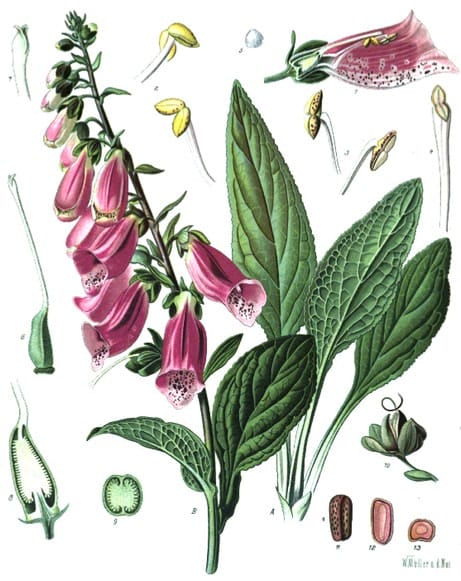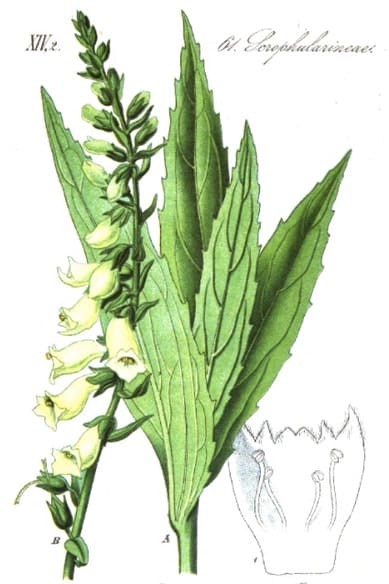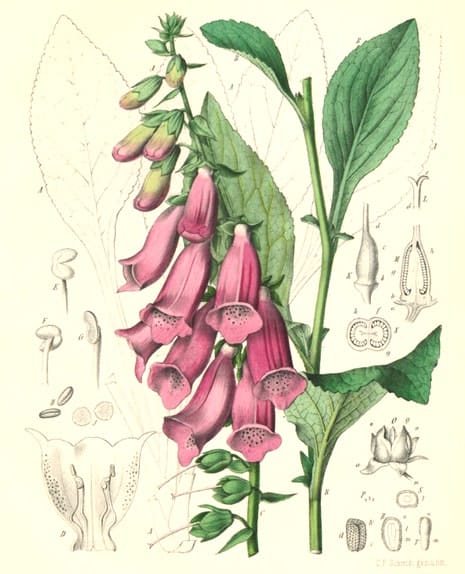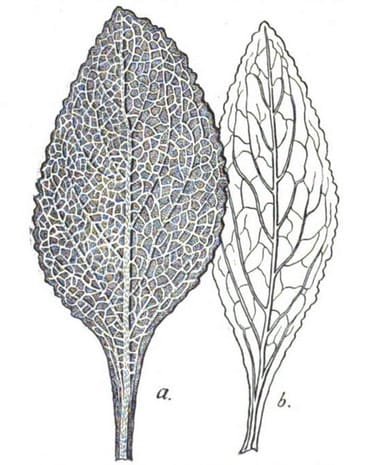Digitalis, FoxgloveFairy Gloves, Fairy Cups, Witches GlovesHritpatri, Tilapushpi (Ayurveda) |

|

|
 D. purpurea
D. purpureaKoehler’s Medizinal Pflanzen, 1887 |
 D. lutea
D. luteaFlora von Deutschland (17), Kohler, 1884 |
 Atlas der Officinellen Pflanzen, Berg & Schmidt, Leipzig, 1893
Atlas der Officinellen Pflanzen, Berg & Schmidt, Leipzig, 1893 Foxglove leaf
Foxglove leafNotes on Pharmacognosy,
Otto Augustus Wall, 1902
Botanical name:
Digitalis purpurea (and subsp. inc. heywoodii);
D. lantana and D. lutea have been used also, especially as alkaloidal sources, D. lantana being 3-4 times as potent as D. purpurea.
Parts used:
Leaf; occasionally the seeds
Leaf is gathered when coming into flower, preferably from 2-3 year old plants, and dried quickly in a temperature of 30–60˚ C.
Temperature & Taste:
Warm, dry. Bitter. Toxic
Uses:
1. Strengthens the Heart, Moves the Blood, Regulates the Pulse:
-increases heart blood nutrition.
-Heart disease; Cardiac or Nephritic Edema.
-excitement where the Heart beats rapidly, but weakly.
-labored breathing with a weak pulse
-valvular diseases, including dilation with mitral or tricuspid incompetence, or mitrial or tricuspid lesions.
-Modern medicine uses Digoxin as the drug of choice for fast atrial fibrillation, and cases of Congestive Cardiac failure with arrhythmia.
-desquamative Nephritis associated with Heart weakness
2. Clears Heat and Phlegm, Stops Cough:
-thick phlegm in the chest obstructing the Lungs or Heart (decocted in honey water)
-‘cuts and consumes the thick toughness of gross and slimy phlegm and naughty humours’. (Gerard)
-inflammatory conditions of the Lungs, Pleurisy, with Spitting of Blood
-‘Of great use as a cardiac stimulant in acute Pneumonia’.
-Whooping Cough and Asthma.
3. Clears Phlegm, Resolves Masses:
-Tumors including swollen Lymph Nodes, Scrofula, Fibroid Tumors and Cancer.
-It has occasionally been used for Cancer in the past, but has had numerous research in recent years proving its efficacy against various cancers, and its synergistic effects with some chemotherapeutic drugs.
4. Settles Wind:
-Epilepsy, Paralysis and Mania associated with Heart weakness.
5. Resists Poison:
-An antidote to Aconite poisoning.
6. Emetic:
-Previously used as an Emetic; vomits and purges violently in full doses. (Decoction)
7. Externally:
i. applied to fresh and old Wounds, Old Sores, chronic Ulcers, scabby Head, Itching
ii. also applied to Lymphadenitis, Nodes and Tumors (as a wash or compress).
iii. ‘Locally, Digitalis is used in Joint Inflammation’
Dose:
1. ‘Full doses are necessary to produce its effects, and unless it is pushed no result may be obtained in cases which would at once react to large doses’ (Squires). Never prescribed in large doses initially. It is best taken after meals to eliminate nausea and stomach upset.
2. The Tincture (BP) is said to be the most reliable way to use this medicine, although some preferred the fresh infusion. However, the tincture is better handled than the infusion, leading some to say that alcohol opposed the specific action of the plant, being a kind of corrective, and therefore, admirable and a better and safer mode of use.
3. Withering preferred the Infusion (see below). He advised continuing its use until it acts on the stomach, kidneys, pulse or bowels, then stopping or reducing the dose once any of these effects manifested.
4. ‘Some strong Rustics venture on a decoction of the leaves in water, for a Vomit’. (Medicina Britannica, Thomas Short, 1746)
POWDERED DIGITALIS (BP): 30–100mg (½–2 grains). Single doses of up 200mg have been given. Maximum daily dose of 500mg–1 gram (traditional dose: 1–6 grains [0.065–390mg]; evidently in Unani medicine, doses of 1000–1500mg are given per day). Maintenance doses of 100mg are used once therapeutic efficacy has been established;
Of the TINCTURE of the LEAF (B.P., 1:10): 4–8 (up to 15) drops may be given. A good method of using the Tincture was to add 5 drops to 10 teaspoonfuls of water, mix well, and give in teaspoonful doses every 2-4 hours. This is good for Angina Pectoris etc.;
Of the DRIED LEAF in INFUSION: Withering preferred to use Digitalis in Infusions. He advised 1 dram (3.8 grams) of the dried leaves to be infused for 4 hours in half a pint of boiling water, adding to the strained liquor half an ounce of any spiritous water. The dose was 1 ounce twice daily to an adult. In strong people or urgent cases, this dose was given once every 8 hours, and in many instances half an ounce as a dose was deemed sufficient;
In DECOCTION: In old usage, it was not uncommon to decoct 1 handful of the leaf to be taken over the course of the day. This dose is not specific enough for modern use. It is not certain if boiling lessens or destroys the toxic compounds.
As an EXTERNAL WASH, 1 teaspoonful of the Tincture, or 2 teaspoonfuls of the herb may be added to 500mls of water. In small wounds, a little of the undiluted tincture may be applied directly.
Substitutes:
1. Lily of the Valley is considered to be a safe alternative to Foxglove, which may be alternated with Foxglove in clinical treatment.
2. Hawthorn is also used similarly, but can potentiate the toxicity of Digitalis.
3. Strophanthus has also been used similarly.
4. Some considered Tincture of Mistletoe as a good substitute for Digitalis.
5. Bugleweed (Lycopus) was regarded as a non-toxic substitute to slow the pulse.
6. Unani has used Rauwolfia as a substitute (500mg per dose).
Main Combinations:
1. Palpitations, Foxglove with Henbane
2. Wheezing, Asthma:
i. Foxglove with Licorice
ii. Dried Foxglove leaf (4 oz.), Masterwort (1 oz.), Rue, Wormwood, Elecampane, Comfrey (2 oz. each), Lungwort, Wild Cherry bark (1 oz. each); cover with 1 gallon of boiling rain water, keep warm 12 hours, strain, add 4 quarts of Honey and keep warm another 12 hours. Strain and keep in bottles. Dose 1 tablespoon which can be increased to a wineglassful. (Madame Young’s Guide to Health, 1858)
3. Diuretic, for Edema:
i. Tincture of Foxglove (3 drams), Tincture of Squill (1 dram). Dose: 30 drops, 2–3 times daily. (Sobernheim, 1840)
ii. Foxglove with Juniper
iii. Foxglove with Cinnamon
iv. Foxglove with Squill, Juniper, Gentian
v. Foxglove with Squill, Juniper, Licorice, Cinnamon (Sobernheim, 1840)
vi. Foxglove, (half dram each), Clove Juniper, Senega (1 oz. each), Cayenne (2 grains). Boil in 3 pints of water for half an hour, dose is a wineglassful three times daily.
vii. Foxglove (2 grains), Saltpeter (8 grains). Powder and divide into 6 doses. Take 1 dose 3 times daily. (Sobernheim, 1840)
4. To promote Menstruation, Foxglove with Myrrh
5. Nervous diseases, Epilepsy, Hysteria, Foxglove with Asafetida, Scullcap, Clove
6. Mania, Spasms, Foxglove with Henbane and Camphor
7. Cancer, Foxglove was combined with Fowlers Tincture of Arsenic. (‘Minutes of Cases of Cancer and Cancerous Tendency, successfully treated by Mr Samuel Young, Surgeon’ … by Samuel Whitbread, London, 1815)
8. Topically for Epithelial Cancer, Foxglove with Ground Ivy
9. Itching: “A decoction made with Foxgloves and water, and drunk, is a most excellent remedy for such as are troubled with Scabs or Itch, especially or such as have scabbed heads” (Culpeper’s School of Physick, 1678)
10. Scabbed Head, make an ointment with Foxglove and Pig fat.
Cautions:
1. It is best if the medicine is standarised, or to at least know the relative strength of an individual batch. In the past, individual patients were always started on a low dosage, which can be gradually increased to a therapeutic dosage.
2. Preparations of the raw plant should not be taken for prolonged periods of time, as Digitoxin is an accumulative poison.
3. Digitoxin and the other active principles are just as irritant as the infusion or tincture, and are no more effectual or consistent than the standardised tincture, nor are they more readily absorbed. The main advantage of the isolated compounds is their ability to be given intravenously without side effects, and for more precise dosages to be given. It must never be forgotten, however, that the original use of Digitalis for Edema was discovered in 1785 in the formula of an old woman who used Digitalis as a tea; Culpeper and others also talk of Infusing or Decocting the plant with no mention of any danger or caution. So it can potentially be used in its dried form, as long as a low dose is used as a starting point.
4. Not used in fatty degeneration of the Heart, extensive arterial degeneration, aneurism, sinus arrythmia or myocarditis. It can be dangerous in these conditions. Raised Blood Pressure is no contraindication to its use, ‘except in Gouty Kidney with high blood pressure’. (Squires)
5. ‘Its continued use deranges the alimentary system; therefore, after it has been taken for 8 or 10 days it should be discontinued for 3 or 4 days’. (Squires)
6. Avoid during Pregnancy
Toxicity:
1. Toxic symptoms include the pulse becoming irregular, blood pressure is lowered and there is gastrointestinal irritation. Large doses cause cerebral symptoms, which may effect the vision etc.
2. Overdose can cause Cardiac Rhythm disorders, Tachycardia, and AV Block. Stupor, Visual disturbances, confusion, hallucinations and psychoses may occur.
3. Lethal doses cause Heart Failure and Asphyxiation.
4. It has been stated that the poison Digitalin only develops when the herb is exposed to the sun, the plant being inert when collected from shady places.
5. Grieves stated that constant use of Digitalis causes hypertrophy of the Heart.
6. Abuse of Digitalis
7. Poisoning by Digitalis
8. Digitalis Poisoning
9. Digitalis Intoxication
10. Atrial Tachycardia with Atrioventricular Block Due to Digitalis Poisoning
Treatment of Overdose
Production, Recognition and Treatment of Digitalis Intoxication
Drug Interactions:
1. Not used in people who are already taking Cardiac Glycosides from Western Medicine (such as Digoxin).
Antidote:
1. Vomiting should be excited, followed by 1 teaspoonful of Charcoal; after this, milk and strong tea may be given. If the pulse is very weak, hold Smelling Salts (Ammonia) under the nose, and give a teaspoonful of Whisky every 20 or 30 minutes until 6 or 8 doses have been taken.
2. Aconite was said to be physiologically opposite to Foxglove.
3. ‘In case of an over dose, a recumberant posture is of paramount importance; and after the stomach has been emptied, 20 grains of Tannic Acid in hot water given frequently, or hot strong Tea or Coffee; stimulants and warmth’. (Squires)
4. Protective effects of Hawthorn (Crataegus oxyacantha) extract against digoxin-induced arrhythmias in rats
Main Preparations used:
Powder, Tincture; Extract
1. Powder of Digitalis purpurea:
i. Dried leaves of Digitalis purpurea, White Sugar (1 dram each). Powder and divide into 24 doses to be taken 1–3 times daily. (Pharmacopee Usuelle, Louvain, 1821)
ii. Dried leaf of Digitalis purpurea (1 grain), White Sugar (1 scruple). Mix for a dose. (Pharmacopoeia Militaris, 1818)
iii. Dried leaf of Digitalis purpurea (2 grain), Calamus (5 grains), White Sugar (13 grains). Mix for 2 doses (Pharmacopoeia extemporanea, Augustin, 1822).
2. Tincture of Digitalis purpurea:
i. Dried leaves of Digitalis purpurea (4 oz.), Proof Spirit (2 pints). Macerate 14 days, filter. Dose: up to 30 drops.
3. Extract of Digitalis purpurea:
i. Fresh Foxglove leaves, bruise in a stone mortar, sprinkling with a little water. Express the juice and immediately evaporate in a water bath, stirring constantly towards the end with a spatula. (Pharmacopoeia Hannoverana, 1819)
4. Diuretic Powder:
i. Dried leaves of Digitalis purpurea, Cinnamon (1 scruple each), White Sugar, Potassium acetate (4 scruples each). Mix. Dose: 15–20 grains. (Dispensatorium Fuldense, 1791)
ii. Dried leaves of Digitalis purpurea (15 grains), Potassium nitrate (3 drams), Cream of Tartar (4 drams). Mix, divide into 6 doses, one to be taken every 2 hours.
iii. Dried leaves of Digitalis purpurea, Squill (1 grain each), Oil of Juniper (2 drops), Cream of Tartar, Licorice (1 scruple each), Cinnamon (2 grains). Mix. Take as a dose, 2 or 3 times daily.
-
Extra Info
- Research
